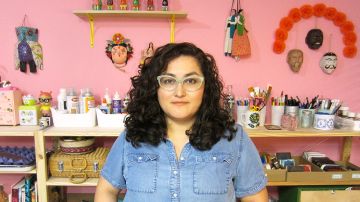Ana Serrano’s Artwork Pays Homage to Latinos in L.A.
We talk about the ways redlining has been used to corral people of color into segregated neighborhoods and institutions

Photo: Courtesy of PMCA/Ana Serrano
We talk about the ways redlining has been used to corral people of color into segregated neighborhoods and institutions. But we rarely focus on the ways interacting with these, often polarized physical spaces, contextualizes the way Latinos understand their worth in the United States. Ana Serrano’s art is deeply impacted by the way she experienced the difference between redlined and “desirable” landscapes.
Serrano is a first gen kid with roots in Sinaloa, Mexico.“My grandma came here first,” she told HipLatina. “She came in the early 70’s, and she came and started working and sending money back to my Mom and my Aunt, who she left behind, and they came to join her in the mid 70’s. I am was born in East LA in ‘83. We lived in South LA, on the border of LA and Vernon, which is a very industrial part of town.”
When she was nine her mom moved to Downey, a predominantly White town on the Eastside of Los Angeles. Serrano recalls noticing the glaring difference between where she grew up and her new neighborhood.

“There was a lot of small little culture shock moments, where I was like, ‘What?! This really happens?’ And I think that’s when I started noticing the difference in neighborhoods,” Serrano says. “How different it was moving from South LA, where we would be careful walking out at night, you have experiences with people getting shot in your neighborhood, you were aware of all these things. Even the liquor stores you had around you. I could walk to two liquor stores. Even having a lawn, [in Vernon] we lived in a back house, and we only had concrete.”
Serrano’s art does what many Latino artists do with their classically honed art school skills—they paint, sculpt, draw and create what they know. They elevate the mundane or the seemingly unimportant and it becomes something deemed “worthy” of being seen—or at least that’s the idea. Women of color make up a tiny percentage of the artists featured on gallery walls but the lack of diversity in the art world is a whole different article for another day. Serrano is most known for her work with cardboard—which would seem an unusual medium of choice. She creates both miniature and life size buildings typically found in East LA/Latino neighborhoods. Serrano attributes her ability to find her niche with the flexibility of her Art Center courses.
“The professors had no problems of me fulfilling my assignments three dimensional. One of the first things I built was a whole set for this stop motion act animation. It went from that,” she says.
As Serrano kept building 3 dimensional structures she gravitated toward cardboard out of necessity but admits that she also uses it because people’s perception of cardboard adds an intriguing layer to her work.
“It’s not a typical art material or seen as this long longevity. Its seen as disposable material, and I get that perception a lot from people that it’s like, ‘Oh why are you working with this, its not going to last very long?’ or ‘it’s not a traditional art material,’ but it’s a material that’s very accessible and when I started working with it, it was what I could afford,” she says.
If you wanted to get conceptual, one might argue that her medium is a metaphor for the Latino experience or at least how its perceived—necessary, useful, resilient but still unimportant.

Serrano’s latest show “Homegrown” at the Pasadena Museum of California Art (PMCA) explores the way Latinos interact with urban landscapes, especially since so many Latino immigrants come from rural areas and are suddenly expected to survive in neighborhoods removed from the natural.
“Homegrown” features pastel painted concrete and house plants, nopales, chili de arbol, aloe vera, among other yerbas tipicas in a “concrete structure.” Mainly it just emphasizes our desire to put down roots, beautify the undesirable, and thrive with what we have.
“We’re very resourceful people, and we use everything that we have. I think that makes another connection with the work” Serrano said. It was her own family’s ancestral home in Mexico that inspired her project. “It got me thinking about how they were able to live off of the land and have access to a lot of land, and they had all this knowledge of growing plants and food. That’s how my mom grew up. I thought that is so nuts how in this one generation all of that has been lost,” she says.
Serrano is paying homage to neighborhoods that are going extinct and to people who were still able to grow strong communities in toxic soil. And although she recognizes that most of the people who see the exhibit are non-Latino, she creates her pieces with Latino’s in mind. “
“When I make the work I make it for—I don’t make it for the white audience,” she says. “Even though that is who predominantly visits a museum and predominately is engaged with the fine art world, I’m making work with [Latinos] in mind. [My art] is accessible to everybody online, everyone can view it and be a part of it still.”
“Homegrown” will be available for viewing on June 3rd at PMCA and you can keep up with Ana’s work on Instagram.















